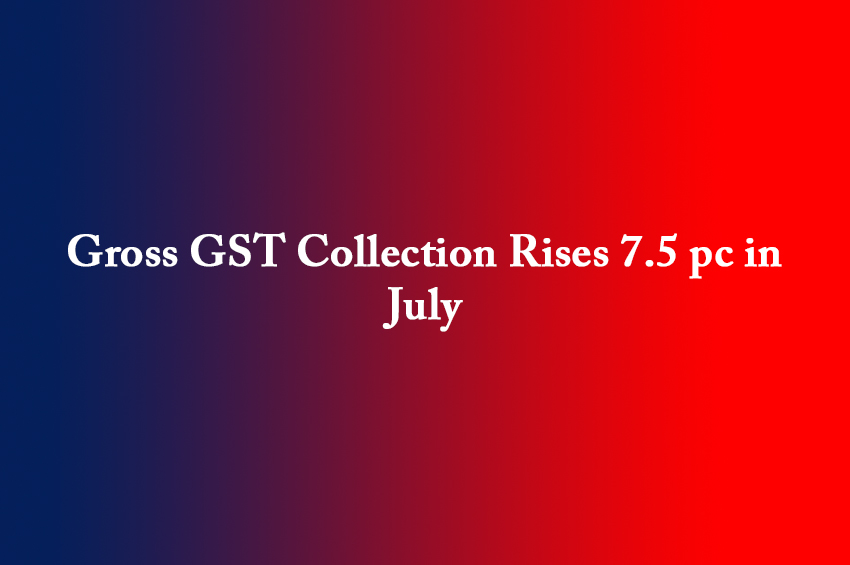Winning Bizness Economic Desk
The country’s gross GST collection increased to Rs 1,95,735-crore in July of this year which is a 7.5 per cent Year-on-Year (YoY) northward movement, data released by the union finance ministry showed.
The northward movement was propelled by higher collections from both domestic transactions and imports. On a year-to-date basis (April-to-July), gross GST revenue climbed up a heathy 10.7 per cent to Rs 8.18-lakh-crore, up from the Rs 7.39-crore in the same period last year.
The total gross GST revenue for July 2025 is as follows—Central Goods and Services Tax (CGST) Rs 35,470-crore, State GST at Rs 44,059-crore, Integrated GST (IGST) at Rs 10,353-crore (inclusive of Rs 51,626-crore collected on imports) and Compensation Cess of Rs 12,670-crore which is inclusive of Rs 1,086-crore collected on imports.
After adjusting for refunds, net GST revenue for July stood at Rs 1,68,588-crore, registering a modest 1.7 per cent increase from Rs 1,65,800-crore in July 2024.
This subdued growth was largely due to a 66.8 per cent increase in total refunds which increased to Rs 27,147-crore in July 2025 from Rs 16,275-crore a year-ago.
A point to note here is that despite the slow monthly growth, the cumulative net GST revenue for April-to-July 2025 increased 8.4 per cent to Rs 7.11-lakh-crore as compared to Rs 6.56-lakh-crore during the same period last year.
Small NE States Register Healthy GST Growths on YoY Basis
Some small north-eastern states have clocked a robust YoY growth in their GST collections in July 2025.
Tripura and Meghalaya registered a 41 per cent and 26 per cent increase in their GST collections. Two other states—Sikkim and Nagaland—clocked a 23 per cent and 22 per cent rise, respectively.
A few of the larger states also garnered healthy GST collections. Madhya Pradesh’s GST revenue expanded 18 per cent while Bihar and Andhra Pradesh clocked a 16 per cent and 14 per cent growth, respectively.
The growth rates of Punjab and Haryana stood at 12 per cent each.
The western coastal state of Maharashtra collected Rs 30,590-crore in July of this year, up six per cent YoY while the two southern states of Karnataka and Tamil Nadu posted a 7 and 8 per cent growth, respectively.
Another western state bordering Maharashtra—Gujarat—witnessed a slow growth at just three per cent while Delhi and Uttar Pradesh (UP) witnessed a modest growth of just two per cent and seven per cent, respectively.
A point to note here is that with the festival season demand expected to begin from mid-August onwards, GST collections in the coming months are likely to be robust.
The festival season is expected to last till March of next year.
Additionally, the government’s continued focus on widening the tax-base, digitisation of compliance and AI-driven audits are also expected to push-up GST collection.
India’s Marine Fish Catch Dips 2 Per Cent in 2024, Gujarat Leads in Landings
India’s marine fish catch dipped marginally in 2024 to 3.47-million tonnes, down two per cent from the previous year, the Central Marine Fisheries Research Institute (CMFRI) said.
Significantly, however, Gujarat landed the most fish for the year at 7,54,000-tonnes. It was followed by the southern coastal state of Tamil Nadu (TN) with 6,79,000-tonnes and Kerala, a neighbouring southern state, with 6,10,000-tonnes, the CMFRI said in its annual estimates.
Indian mackerel topped the catch list at 2,63,000-tonnes, followed by oil sardine at 2,41,000-tonnes. Across the country, landings of mackerel, threadfin breams, oil sardine, ribbonfish, non-penaeid shrimps and cephalopods declined from 2023 levels.
However, the point to note here is that catches of lesser sardines, penaeid shrimps, anchovies and tuna moved northward.
While the west coast region witnessed an overall slide in landings, the east coast revealed an increasing trend, with exceptions in Maharashtra and Andhra Pradesh, it said.
Maharashtra clocked the highest growth of 47 per cent as compared to the previous year. West Bengal, Tamil Nadu and Odisha also witnessed increases of 35 per cent, 20 per cent and 28 per cent respectively, the release said.
However, states such as Karnataka, Goa and Daman and Diu experienced significant declines in landings, it said
The CMFRI said, in total, about 2.5-lakh fishing trips were monitored, offering an in-depth view into nation-wide efforts and productivity.
According to the CMFRI report cyclonic storms such as Daba, Fengal, Remal and Asna significantly impacted fishing activities contributing to the overall slide.
Additionally, the increased heatwave days in Andhra Pradesh and Kerala further adversely affected fishing operations. Kerala registered a marginal decrease of four per cent in the marine fish catch in 2024 as compared to the previous year, totalling a landing of 6.10-lakh tonnes.
India’s Tea Production Dips 9 Per Cent in June
The country’s tea production slid nine per cent to 133.5-million kgs in June of this year as compared to the same month of the previous year (2024), according to official data from the Tea Board.
In June 2024, the country had produced 146.72-million kgs of tea, according to Tea Board data. According to the Indian Tea Association, the dip in production was caused by adverse weather conditions and pest attacks.
Production in north India comprising West Bengal and Assam slid to 112.51-million kgs in June. The figure stood at 121.52-million kgs in June of last year.
Production in south India during June also declined to 20.99-million kgs as against 25.20-million kgs in the same month of the previous year.
Big and organised planters produced 55.21-million kgs in June, a decline from 68.38-million kgs in the same month of 2024.
Production from small growers stood at 68.28-million kgs during the month, a dip from 78.34-million kgs in June of last year.
The production volume of the CTC variety was 117.84-million kgs, followed by orthodox at 13.82-million kgs and green tea at 1.84-million kgs.
Himachal Pradesh Board to Introduce Horticulture as Vocational Subject
Horticulture will be introduced as a vocational subject in schools affiliated with the Himachal Pradesh Board of School Education (HPBOSE), the state’s Education Minister Mr Rohit Thakur said recently.
Chairing a review meeting with senior officers of the Education Department and HPBOSE to assess the progress of various educational schemes and discuss key matters concerning the department, Mr Thakur said that the decision to include horticulture as a vocational subject in schools was taken in the meeting.
The minister instructed HPBOSE to prepare a suitable curriculum for the subject and submit the proposal within two-weeks and also emphasised the need to revive important academic subjects such as public administration in colleges to offer students a broader choice of disciplines, a statement said.
India’s Defence Production Reaches Record High of Rs 1.5-lakh-cr in FY 25
India’s defence production has reached an all-time high of Rs 1.5-lakh-crore in the fiscal year 2024-25 (FY25), the country’s Defence Minister Mr Rajnath Singh said in a social media post.
“The annual defence production has soared to an all-time high figure of Rs 1,50,590-crore in the financial year 2024-25,” Mr Rajnath Singh said in the social media post.
The production increased around 18 per cent when compared to the previous fiscal year’s total output of Rs 1.27-lakh-crore.
“These numbers indicate a robust 18 per cent growth over the previous fiscal’s output of Rs 1.27-lakh-crore, a staggering 90 per cent increase from 2019-20, when the figure was Rs 79,071-crore,” Mr Singh said.
India’s Defence Minister praised the “collective efforts’’ of the Department of Defence Production and all stakeholders including the Defence Public Sector Undertakings and the private industry in achieving what he called a “landmark”.
“This upward trajectory is a clear indicator of India’s strengthening defence industrial base,” he said.
Defence exports had climbed up creditably to a record high of Rs 23,622-crore in FY 25. It was a growth of Rs 2,539-crore or 12.9 per cent over the defence export figure of FY 24 which was Rs 21,083-crore.


